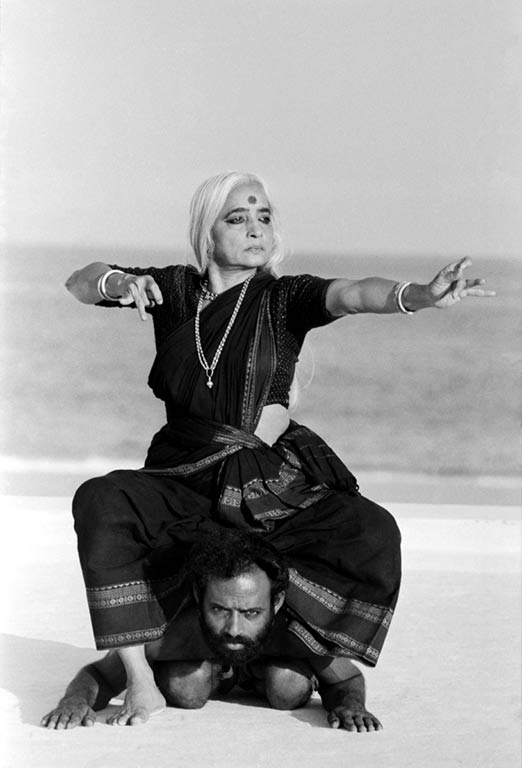Bodies in Motion
What happens to the memory of a revelatory experience when it is re-watched through the frames of a screen? It somehow makes the edges sharper and the focal point clearer, as we discover through Chandralekha’s iconic Sharira
Seema Prema Bhagyam Massot
The library at the Alliance Française of Madras was packed. They had brought in extra chairs from the classrooms – the ones with the little foldable tables – and still there wasn’t enough for everyone; this turned out be a good thing for me. That afternoon, late in 2004, still early in the new millennium, we were gathered for a discussion with Chandralekha, the woman who redefined the horizons of contemporary dance, about her latest creation, Sharira. And I found myself seated on the floor right in front of Chandralekha, literally at her feet – it was like a premonitory set-up for another kind of learning at the Alliance Française.
It was here that I first saw some excerpts of Sharira – on the library’s TV set, a few weeks before seeing the full-length live version at Spaces, Besant Nagar. It was simply a revelation. The dance was nothing like what I knew dance to be, and my epiphany came shortly after when Chandralekha started to talk. Dance, she said, was not just performance. That is when it dawned on me that ‘dance’ is a noun and a verb unto itself; it did not need the suffix of ‘performance’. Dance can be contemplative and meditative, with movement and aesthetics being only a part of it. Then she said something that forever changed the way I would consider women on stage – Chandralekha talked about how aesthetics evolved to please the male gaze.

*****
On a relatively cool evening, across the road from Elliot’s beach, one of the stages at Spaces was set up. We left our footwear outside and sat on the sandy floor; there were also people sitting on benches around the compound wall. During the first twenty minutes of Sharira, we engaged with dancer Tishani Doshi who completely operated on the horizontal plane – that is, the floor. The movements and positions were complex, as she used a yoga-inspired vocabulary at an astonishingly slow pace that only spoke of her strength and the measured, deliberate tone left no room for a contortionist-like spectacle. With the arrival of Shaji, the vertical space began to open up as he brought in movements rooted in the ancient South Indian martial art form of kalaripayattu. Their bodies moved in a meditative rhythm, as the Gundecha Brothers’ deep voices surrounded us all – dancers and the audience – into a permeable bubble. The images, questions, reflections that emerged were many – sensuality, power, sex, strength, beauty, and much more. I could feel people seated around me, their gentle exclamations, their bodies moving in response to what we were seeing. I felt deeply the sand beneath my bare feet as I sat there hugging my knees, the salty sea breeze that set in, the bells of street vendors and the sporadic laughter of people leaving the beach nearby.

*****
When I knew I had to watch Sharira on the Internet again, some 15 years after the original experience, I put it off for a whole week during which I just basked in its memory (I have watched it at least twice in person). It came to me like waves, then flashes, before settling into a steady stream of images, thoughts and music. When I closed my eyes, I could see the shadow-silhouettes of the dancers forming triangles, symbolising the feminine energy. The exhilaration I recalled was not unlike remembering swimming in the sea for the first time after having only known still watered, artificial swimming pools. Now, during a pandemic, when we are all trying to protect our bodies, Sharira’s memory served to highlight the body’s primal beauty; it was like finding a glorious light in pitch black darkness. This recollection also came with the realisation that the experience I had at 18, of listening to Chandralekha talk about Sharira and then watching it was one of the fundamental building blocks of not only my feminist values but also the relationship with my own body.

Finally, I did watch it online, which inevitably led to reading about it too. The articles, comments and even the interviews with Chandralekha were all rich and interesting, to say the least, but I watched the hour-long dance over three sittings – at home it was impossible to ignore other demands and such is the nature of the Internet viewing beast. The video recording was good, but how could it capture the parallel action on the wall behind the dancers where the shadows were coming alive? Does the camera with its imposed angles and frames allow you to follow or un-follow the action or the music as and when they move you? It was the difference between watching and witnessing.

Can Sharira – that by its very design exalts the physical body in all its sensual, sexual and spiritual glory, where even the changes in breath of the dancers and the audience add to the experience of authenticity – ever be captured? What would Chandralekha have said about the online experience quickly replacing the lived reality in these times? In the end, watching it online confronted the impressions of the dance I had carried inside me for 15 years, of my memories mulled and fermented since witnessing Sharira, and of the heady, delicious nostalgia inevitably scented by the sea breeze.
Share